Wearable Sculpture - Art Gallery of Nova Scotia
Wearable Sculpture - Art Gallery of Nova Scotia
Wearable Sculpture - Art Gallery of Nova Scotia
Create successful ePaper yourself
Turn your PDF publications into a flip-book with our unique Google optimized e-Paper software.
Journey Into Time -The <strong>Art</strong> <strong>of</strong> the Ancient Mediterranean“Road <strong>of</strong> Life” “Looking Inwards” “Roots and Veins”Wire, felt and cardboard Beads, safety pins, mirror Twigs, paper, bark and wireGrade 11 Grade 11 Grade 11Title: <strong>Wearable</strong> <strong>Sculpture</strong>Developed by: Robin JensenSuggested grade level: 11-12Length <strong>of</strong> time: 2-3 weeks <strong>of</strong> 1-hour classes per daySubject Areas: Visual <strong>Art</strong>, History, Language <strong>Art</strong>sRational:Throughout the ages, people have created and worn body adornments to represent manyaspects <strong>of</strong> their lives, belief systems, geography, and artistic abilities. The jewelry that wechoose to wear <strong>of</strong>ten defines us as individuals and as a society. In an exploration <strong>of</strong> thejewelry and traditions <strong>of</strong> ancient Mediterranean and our own cultures, students will beencouraged to expand and challenge their notions <strong>of</strong> body adornment and sculpture whileexperimenting with non traditional materials and techniques to communicate an intendedmeaning through their work.Logistics:Classroom set up:This project is intended to be completed by each individual student in the classroom butcould easily be adapted for students working in small groups.
Materials:This project requires a large collection <strong>of</strong> found materials such as fabric, wire, old toys,shells, wood scraps, yarns, or tinfoil; anything easily found and replaced. Tools such ashot glue guns or pliers are also useful to encourage a wide range <strong>of</strong> responses to thisproject. Students should be responsible for bringing in the materials not readily availablein the class that they will need for their designs.Suggested resources/images:- The Newark Museum website: “Baubles, Bangles, and Bling Bling”- www.ancientegypt.co.uk look for “jewelry workshop”- Images gathered from the website, magazines, posters, photos in texts on theAncient MediterraneanSuggested Outcomes:While specific Department <strong>of</strong> Education outcomes have not yet been finalized for grade11 and 12, some <strong>of</strong> the Key Stage Outcomes that can be achieved by this project are asfollows:• Students will be expected to create and or present collaboratively andindependently expressive products in the arts for a range <strong>of</strong> audiences andpurposes.• Students will be expected to demonstrate critical awareness <strong>of</strong> and value for therole <strong>of</strong> the arts in creating and reflecting culture.• Students will respect the contributions <strong>of</strong> the arts <strong>of</strong> individuals and culturalgroups in local and global contexts and value the arts as a record <strong>of</strong> humanexperience and expressionIntroductionUsing available resources, invite students to investigate and discuss the jewelry <strong>of</strong> theancient Mediterranean. They may work individually or in small groups to respond toquestions in their sketchbooks or they might discuss and write about specific images <strong>of</strong>Mediterranean jewelry that have been collected. Students may also be asked to researchthis topic online. Consider these discussion points:• Who might have worn these objects? At what time <strong>of</strong> day/month/year? In whatsettings?• What do these pieces tell us about the artist, the wearer, or the culture in which itwas worn?• Has today’s jewelry remained the same or changed from the time <strong>of</strong> the ancientMediterranean? In what ways?• Do we have new forms <strong>of</strong> adornment that did not exist in ancient times? If so,what are they?• How might you define the term “jewelry”?• Why do we continue to wear objects made for the same locations on our bodiesand <strong>of</strong>ten using similar materials?• Does an object have to be worn to be considered jewelry?
• What is the difference between sculpture and jewelry?Suggestions For Teaching and Learning:• Students will be encouraged to make wearable sculpture using materials they havecollected. The student does not actually have to wear the piece; it can be createdfor anyone. It does not have to be comfortable, practical, or beautiful. Encouragestudents to make an object that is not conventional or easily recognizable as aring, necklace, bracelet, crown, or earrings. Invite them, instead, to createsomething such as an object for the ear that continues down the shoulder andalong the arm or an object that begins on a finger like a ring but has long fringesthat reach to the floor.• Jewelry <strong>of</strong>ten tells us something about the wearer: life passages, economic class,social standing, political <strong>of</strong>fices, spiritual or religious affiliations, etc. Studentsmight imagine how their sculptures will do this. They should be encouraged tomake connections between the materials and the form and function <strong>of</strong> the object.For example, they might design an armband made <strong>of</strong> velvet with s<strong>of</strong>t materials onthe inside but contrasting sharp glass, metal, or nails on the outside,communicating the idea <strong>of</strong> someone who is s<strong>of</strong>t and gentle on the inside but whoappears rough and dangerous on the outside. Students should consider how thematerial and form will tell us something about the function <strong>of</strong> their sculpture andhow it changes our perception <strong>of</strong> the wearer. Materials and meaning should worktogether to successfully communicate ideas to the viewer.• Ask students initially to develop their ideas for designs in sketchbooks. Some mayfind it easier to make an initial list <strong>of</strong> materials and techniques they would like touse and then develop the meaning and function <strong>of</strong> the sculpture in such a way thatit complements the materials. Other students will be more comfortable developingthe conceptual side <strong>of</strong> the design first by brainstorming potential purposes ormeanings for the sculpture and then finding suitable material to communicate theintended ideas.• For future assessment purposes, ask students to write down or record in somemanner the initial intended meaning or message <strong>of</strong> the design they are going tomake.• Students should be given sufficient time to research, develop, and discuss ideasbefore beginning the actual construction <strong>of</strong> their designs, (2-4 classes) and thenbegin to work independently towards completion. Some students will work moreefficiently if they set specific short- term goals to be accomplished withinestablished deadlines. Teachers may find that helping each student to refine theirideas will give them the confidence they need to realize their plans.Extension <strong>of</strong> Ideas• Students may be asked to create a small gallery in which ordinary contemporaryobjects are presented as artifacts as they might appear in a museum 1000 yearsfrom now. How does this change the way we see or interpret the objects?Consider how viewing an ancient Mediterranean bracelet in a museum mightchange the way we see its value. Has the object changed into a symbol <strong>of</strong> aculture or is it still just bracelet even if it is never worn?
• Stage a fashion show featuring students’ wearable art for peers, parents,community members• Invite jewelry artists from various cultures in your community to share theirparticular artistry with studentsSuggestions for Assessment:• Invite students to interpret the works <strong>of</strong> other students either verbally or inwriting, focusing on how form and materials are working together tocommunicate an idea. Ask students to discuss alternative interpretations othersmay have had on their work• In a group format, reflect upon ideas and attitudes students may have as to whatthey believe jewelry is and how it may or may not be considered sculpture.• Students might be encouraged to reflect in sketchbooks or journals on the entireprocess from inspiration to completion• Develop, with students, a rubric to help assess their success in achieving theirintentions• Discuss the common experience <strong>of</strong> how artworks <strong>of</strong>ten begin as one idea anddevelop into another and how this may create innovation or frustration• Teachers can observe students during the process for evidence <strong>of</strong> comprehension<strong>of</strong> the connection between materials, meaning and form, the ability to develop aplan and carry it out, innovative uses <strong>of</strong> materials and techniques, insight into theconnection between sculpture and its wearer.


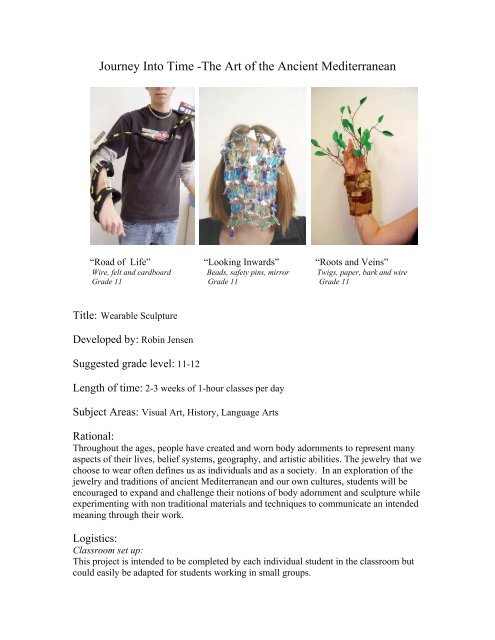
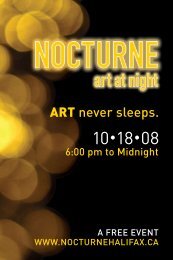
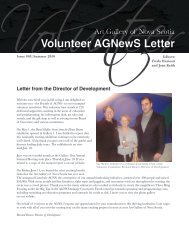
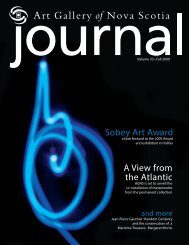

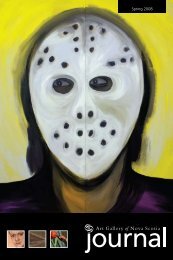

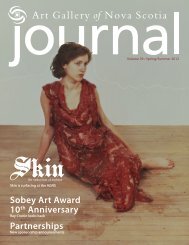
![Elizabeth Bishop - Crazy Quilts and Stories [pdf] - Art Gallery of Nova ...](https://img.yumpu.com/43102277/1/190x245/elizabeth-bishop-crazy-quilts-and-stories-pdf-art-gallery-of-nova-.jpg?quality=85)
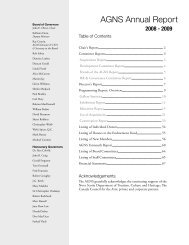
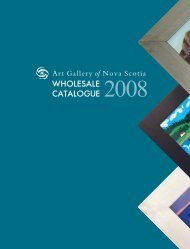
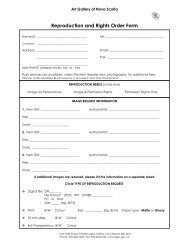
![Senior High lesson plan brochure [pdf] - Art Gallery of Nova Scotia](https://img.yumpu.com/36529943/1/190x146/senior-high-lesson-plan-brochure-pdf-art-gallery-of-nova-scotia.jpg?quality=85)

![Junior High lesson plan brochure [pdf] - Art Gallery of Nova Scotia](https://img.yumpu.com/35457408/1/190x146/junior-high-lesson-plan-brochure-pdf-art-gallery-of-nova-scotia.jpg?quality=85)